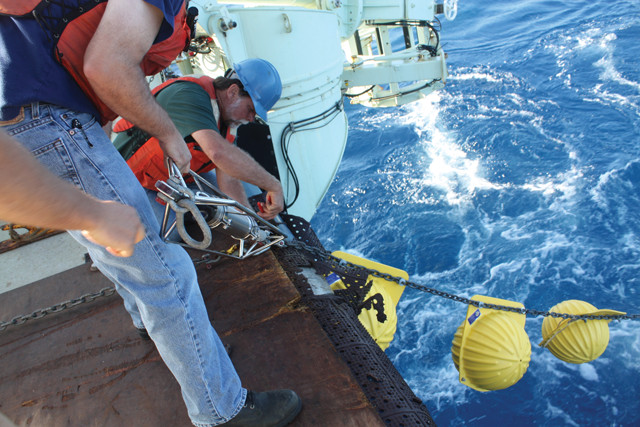
by Adityarup "Rup" Chakravorty Tuesday, February 7, 2017

University of Miami technician Mark Graham attaches an acoustic current meter to a mooring line during instrument deployment operations in the Agulhas Current in November 2011. Credit: James Campbell.
Some ocean currents, like the Agulhas Current in the southwestern Indian Ocean, act like giant air conditioners, moderating Earth’s climate by shuttling heat from the equator toward the poles. The Agulhas is one of the largest and fastest currents in the world: Flowing southwest along the east coast of Africa, it stretches almost 1,500 kilometers and transports about 70 million cubic meters of water every second toward the South Pole at peak speeds upward of 7 kilometers per hour.
Sea-surface temperatures near several currents like the Agulhas, called western boundary currents, have increased more rapidly over the last century compared to temperatures elsewhere in the ocean. This rise in temperature — along with increasing velocities of wind systems across the world — has led researchers to suspect that western boundary currents are gaining strength and transporting more heat poleward.
In a new study in Nature, however, researchers suggest that instead of strengthening, the Agulhas Current is actually broadening and growing more chaotic — thus potentially transporting less heat poleward.
“On a global scale, broadening of the Agulhas Current would mean that the transport of heat towards the poles may decrease, rather than increase, with climate change, leading to warmer tropics and cooler polar regions,” says Lisa Beal, an oceanographer at the University of Miami and lead author of the study.
At the local level, Beal says, it could lead to a larger exchange of pollutants and various animal larvae between the South African continental shelf and the open ocean. “This could affect nutrient flow, larvae survival, and ultimately, ocean productivity and fisheries.”
To determine whether the current has been growing stronger, Beal and her University of Miami colleague, Shane Elipot, used measurements of sea-surface height gradients as a proxy for current strength.
Many factors, such as winds, tides, currents, and differences in temperature and salinity, can lead to some parts of the ocean surface being higher or lower than others. In general, the larger the difference in sea-surface height, or the steeper the slope of the ocean surface, the stronger the current.
Combining more than two decades’ worth of satellite data on sea-surface height with three years of continuous on-site measurements using buoyant sensors moored to the ocean floor, Beal and Elipot found no significant changes in the strength of the Agulhas Current since the early 1990s.They did discover, however, that the offshore boundary of the current had expanded by about 50 kilometers.
It’s possible, Beal says, that, rather than strengthening the linear flow of the Agulhas Current, higher wind speeds above the current are causing its flow to become more meandering or turbulent. Turbulent, chaotic areas within ocean currents are called eddies, and “if a current is eddying and meandering more — sometimes over [distances of] 100 kilometers in the case of the Agulhas — then its path is less linear as it flows, and it gets wider when averaged over time,” Beal says.
An increase in eddy activity could indeed be causing the Agulhas Current to meander and broaden, says Arne Biastoch, an oceanographer at the Helmholtz Center for Ocean Research in Germany who was not involved in the study. But, he says, it’s unclear what exactly is causing these turbulences. “Are these eddies local phenomena or are they drifting in from other regions like the Mozambique Channel?”
The analysis in the new study was confined to a single latitude, 34 degrees south, across the Agulhas Current, but both Beal and Biastoch think that the results can be extrapolated to the rest of this particular current. “The Agulhas Current is relatively narrow at this latitude, so you can measure its entire transport,” Biastoch says, “and any change at 34 degrees south should be seen at other latitudes.”
Figuring out the origin of increased eddy activity could help researchers determine whether the broadening of the Agulhas Current is an isolated incident, or if other western boundary currents might also be getting wider, which some previous evidence has implied.
However, it’s unclear if the results of this study can be extrapolated to the rest of the ocean, Biastoch says, noting that western boundary currents in the Southern Hemisphere are difficult to compare.
Either way, Beal says, “this study will force us to examine some physical assumptions about how the ocean responds to winds, and to consider alternative hypotheses for the warming of currents like the Agulhas.”
© 2008-2021. All rights reserved. Any copying, redistribution or retransmission of any of the contents of this service without the expressed written permission of the American Geosciences Institute is expressly prohibited. Click here for all copyright requests.